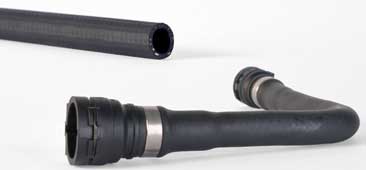 In today’s market, the drive for weight savings is a key focus of every automaker as they strive to improve fuel economy in internal combustion engine (ICE) vehicles and increase the driving range of battery electric vehicles (BEV). The complex thermal management systems of electrified vehicles require robust solutions that maximise performance and minimise overall system weight.
In today’s market, the drive for weight savings is a key focus of every automaker as they strive to improve fuel economy in internal combustion engine (ICE) vehicles and increase the driving range of battery electric vehicles (BEV). The complex thermal management systems of electrified vehicles require robust solutions that maximise performance and minimise overall system weight.
Introduced as a lightweight alternative to traditional EPDM rubber (ethylene propylene diene terpolymer), fluid handling firm Cooper Standard says its TPV hoses perform like cross-linked rubber but are processed like a thermoplastic tube without the need for material compounding or curing.
Hoses made with TPV offer considerable material weight savings, as much as 40% compared to EPDM hoses, and provide increased flexibility compared to thermoplastic tubes of similar size, says the firm.
It adds that the TPV hoses also meet the needs of lower temperatures and system pressures that electric vehicles require.
The company’s TPV hose solutions further complement its complete portfolio of thermal management solutions, independent of a vehicle’s architecture, that also include EPDM hose, mono-wall and multi-layer thermoplastic tubing and quick connectors for both SAE and VDA type connections.
TPV hoses from Cooper Standard provide a smooth internal surface, resulting in a solution that minimizes the impact of pressure losses in a coolant system. Hoses are flexible, but strong using a layer of reinforcing yarn for flexibility during installation and to allow dynamic movement of mating components. TPV hoses connect to the vehicle through traditional EPDM hose connections, such as clamps, or to one of Cooper Standard’s quick connector solutions.
TPV hose features
- TPV hose features
- · Lightweight and recyclable solution
- · High-quality performance during low-pressure drop testing
- · High-quality performance during noise, vibration and harshness testing
- · Durable
- · Flexibility for assembly and dynamic movement on the vehicle
- · Versatile joint geometries (clamp, connector, etc.)
